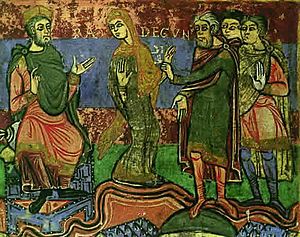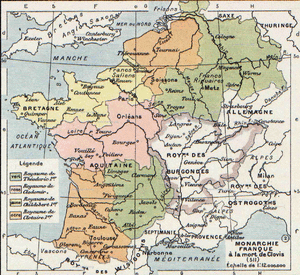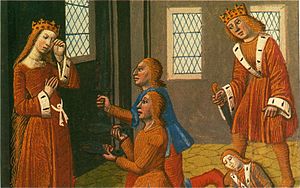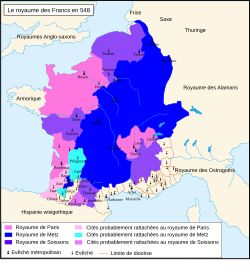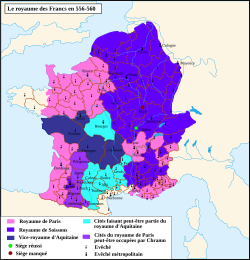Chlothar I facts for kids
Quick facts for kids Chlothar I |
|
|---|---|
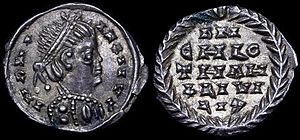
Silver coin of Chlothar I, marked:
d·n· chlothaharivi rex |
|
| King of Soissons | |
| Reign | 511–558 |
| Predecessor | Clovis I |
| Successor | Chilperic I |
| King of Orléans | |
| Reign | 524–558 |
| Predecessor | Chlodomer |
| Successor | St. Guntram |
| King of Reims | |
| Reign | 555–558 |
| Predecessor | Theudebald |
| Successor | Sigebert I |
| King of Paris | |
| Reign | 558 |
| Predecessor | Childebert I |
| Successor | Charibert I |
| King of the Franks | |
| Reign | 558–561 |
| Predecessor | Vacant (last held by Clovis I) |
| Successor | Vacant (next held by Clotaire II) |
| Born | c. 500 (?) |
| Died | December 561 (aged c. 60) Compiègne |
| Spouse | Guntheuc Radegund Ingund Aregund Chunsina |
| Issue | Gunthar Childeric Charibert St. Guntram Sigebert Chilperic Chlothsind Chram |
| Dynasty | Merovingian |
| Father | Clovis I |
| Mother | Clotilde |
| Religion | Chalcedonian Christianity |
Chlothar I, sometimes called "the Old" (in French: le Vieux), was a powerful king of the Franks from the Merovingian dynasty. He was one of the four sons of Clovis I, a famous Frankish king. Chlothar was born around the year 500 and died in December 561, at about 60 years old. The name 'Chlothar' means "glory."
After his father Clovis I died in 511, Chlothar and his three half-brothers, Theuderic, Chlodomer, and Childebert I, divided the kingdom. Chlothar received the city of Soissons, which became his capital. He spent most of his life fighting to make his kingdom bigger. He often worked with his brothers to attack neighboring lands. By the end of his life, Chlothar had managed to reunite the entire Frankish kingdom by outliving his brothers and taking over their lands. However, when he died, the kingdom was again split among his four surviving sons.
Contents
Royal Customs and Inheritance
Chlothar's father, Clovis I, had become a Christian. However, Chlothar and other Merovingian kings did not always follow the Christian idea of having only one wife. Kings often had several wives, mostly for political reasons. This helped them form alliances and gain more power.
Frankish traditions allowed kings to have multiple wives. This was different from the Roman customs influenced by the Church, which preferred one wife. Frankish rulers used these marriages to spread their influence across large areas after the Roman Empire fell. This helped them keep peace and protect their kingdom by making local leaders happy.
In old Germanic traditions, the kingdom usually went to younger brothers or uncles, not sons. But under Salic law, Clovis I changed this. He made it a custom for sons to be the main heirs. However, the kingdom was not given mostly to the oldest son. Instead, it was split equally among all sons. This often caused the large Frankish Kingdom to break into smaller parts.
Family and Marriages
Chlothar had several sons and daughters with different women. According to historical records, he had seven sons. His most important marriage was to Ingund, with whom he had five sons and a daughter.
- Gunthar (died before his father)
- Childeric (died before his father)
- Charibert, who became King of Paris
- Guntram, who became King of Burgundy
- Sigebert, who became King of Austrasia
- Chlothsind, who married the King of the Lombards
Chlothar also married Ingund's sister, Aregund, and they had a son named Chilperic, who became King of Soissons. His last wife was Chunsina, and they had a son named Chram. Chram later rebelled against his father.
Marriage to Guntheuc
Chlothar's first marriage was to Guntheuc, who was the widow of his brother Chlodomer. This marriage helped Chlothar gain control of Chlodomer's wealth. It also made sure Guntheuc kept her lands, as Frankish law allowed women to inherit land if they had no sons.
Marriage to Radegund
In 538, Chlothar married Radegund, a princess from Thuringia. This marriage helped him strengthen his power over Thuringia. Radegund was a very religious woman. She preferred simple clothes and spent most of her time praying and helping the poor. She did not want to live a luxurious life like a queen.
Radegund's strong faith often led to disagreements with Chlothar. She eventually left the royal court and founded a convent in Poitiers, which was the first nunnery in Europe. She later became known as Saint Radegund.
Becoming King and Military Campaigns
When his father Clovis I died in 511, Chlothar received a part of the kingdom. This included the city of Soissons, which he made his capital. He also gained control of cities like Laon, Noyon, and Maastricht. Chlothar was very ambitious and always wanted to make his kingdom larger.
The kingdom was divided among Clovis's sons. Theuderic, the oldest, received half of the kingdom. Chlothar shared the other half with his brothers Childebert and Chlodomer. Chlothar got the northern part, Childebert the central part around Paris, and Chlodomer the southern part around Orléans.
Wars with Burgundy
In 523, Chlothar, along with his brothers Childebert and Chlodomer, attacked the Burgundians. They won a battle, and the Burgundian king, Sigismund, was captured and killed. However, Sigismund's brother, Godomar, took over, and the Franks had to leave.
In 524, Chlothar and his brothers tried again. But they lost a major battle, and Chlodomer was killed. The Franks left Burgundy, and Godomar ruled until 534. Later, in 534, Chlothar and his brothers invaded Burgundy again. This time, they conquered the kingdom and divided it among themselves. Chlothar received cities like Grenoble and Die.
Conquering Thuringia
In 531, Chlothar helped his half-brother Theuderic conquer the Thuringians. The Thuringian kingdom became part of the Frankish lands. During the division of the captured lands, Chlothar and Theuderic argued over who would marry Princess Radegund. Chlothar won because his soldiers had captured her.
Taking Over Orléans
After his brother Chlodomer died in 524, Chlothar and his brother Childebert wanted to take over Chlodomer's kingdom of Orléans. Chlodomer had three young sons. Chlothar and Childebert threatened the boys, saying they had to become monks or die. Their grandmother, Queen Clotilde, was very upset. She said she would rather see them dead than have their royal long hair cut, which was a symbol of their royal status.
Chlothar and Childebert went ahead with their plan. Two of the boys were killed. The third son, Clodoald, managed to escape and chose to live as a monk. This allowed Chlothar and Childebert to divide the kingdom of Orléans between them.
Wars with the Visigoths
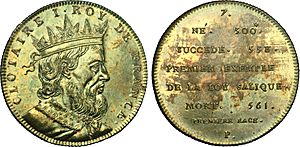
The Visigoths in Spain had taken some Frankish lands over the years. Chlothar sent his sons to get these lands back. His eldest son, Theudebert, was successful in taking back several strongholds.
In 542, Chlothar and Childebert, along with three of Chlothar's sons, led an army into Visigoth Spain. They captured Pamplona and Zaragoza. They were eventually forced to leave, but they gained some important lands beyond the Pyrénées mountains.
Civil War and Peace
Chlothar tried to take advantage of his half-brother Theuderic's illness to gain his kingdom. However, Theuderic's son, Theudebert, quickly returned to help his father. After Theuderic died, Theudebert managed to keep his kingdom from his uncles.
Later, Childebert and Theudebert joined forces and declared war on Chlothar. They defeated him at first, forcing him to hide in a forest. A big storm then hit, damaging their equipment and horses. This forced Childebert and Theudebert to stop their attack and make peace with Chlothar.
Gaining More Land
In 537, a conflict started between the Eastern Roman Empire and the Ostrogothic kingdom. To keep the Franks neutral, the Ostrogothic king offered them the region of Provence. Chlothar received cities like Orange, Carpentras, and Gap.
When Theudebald, Chlothar's great-nephew, died without children in 555, Chlothar immediately went to Metz to take over his kingdom. To make the takeover smoother and form an alliance with the Lombards, Chlothar married Theudebald's widow, Waldrada. However, the bishops did not approve of this marriage and forced Chlothar to divorce her. To make up for this, Chlothar gave his daughter, Chlothsind, in marriage to the Lombard prince.
Wars with the Saxons
In 555, Chlothar attacked and conquered the Saxons, who had rebelled. He made them pay a large yearly tribute, including 500 cows.
Between 555 and 556, the Saxons rebelled again. Chlothar wanted to make peace, but his soldiers forced him to fight. After a very bloody battle, the Saxons and Franks finally made peace.
War with His Son Chram
Chlothar sent his sons Charibert and Guntram to fight against his rebellious son Chram. Chram had gained control of a large area and wanted to break away from his father completely. He even teamed up with Childebert, who encouraged his rebellion.
Chram's army met his half-brothers' army, but a storm stopped the battle. Chram then sent a false message to his half-brothers, saying that Chlothar had died. Charibert and Guntram immediately left for Burgundy. Chram then took the chance to expand his influence.
Uniting All of Francia
On December 23, 558, Childebert died without children after a long illness. This allowed Chlothar to reunite the entire Frankish Kingdom, just like his father Clovis had done. Even Paris, which had fought against him, submitted to his rule.
Chram, still rebelling, sought help from the Bretons. Chlothar, along with his son Chilperic, marched against Chram. Chram tried to escape by sea but was captured. He was then killed. Overwhelmed with sadness, Chlothar went to Tours to pray for forgiveness and died shortly after at his palace in Compiègne.
Relations with the Church
Chlothar tried to collect taxes from churches, even though they were usually exempt. The Bishop of Tours, Injuriosus, refused and left his area. Chlothar replaced him with someone from his own household. Chlothar also exiled the bishop of Trier for being too strict about church rules.
Chlothar and his wife Ingund made many gifts to churches, including decorations for the tomb of Saint-Germain Auxerre. Chlothar also helped pay for the building of the Sainte-Croix monastery in Poitiers, where Radegund lived.
Death and Succession
Chlothar died at the end of 561 from a lung illness, at about 64 years old. At the time of his death, the Frankish kingdom was at its largest, covering almost all of modern-day France and parts of Germany. He was buried in Soissons, in the Basilica of St. Marie.
After his death, the kingdom was divided among his four surviving sons:
- Charibert received the old kingdom of Childebert, including Paris and Aquitaine.
- Guntram received Burgundy and part of the Kingdom of Orléans.
- Sigebert received the Kingdom of Metz.
- Chilperic received the northern territories of the Kingdom of Soissons.
Images for kids
See also
 In Spanish: Clotario I para niños
In Spanish: Clotario I para niños


